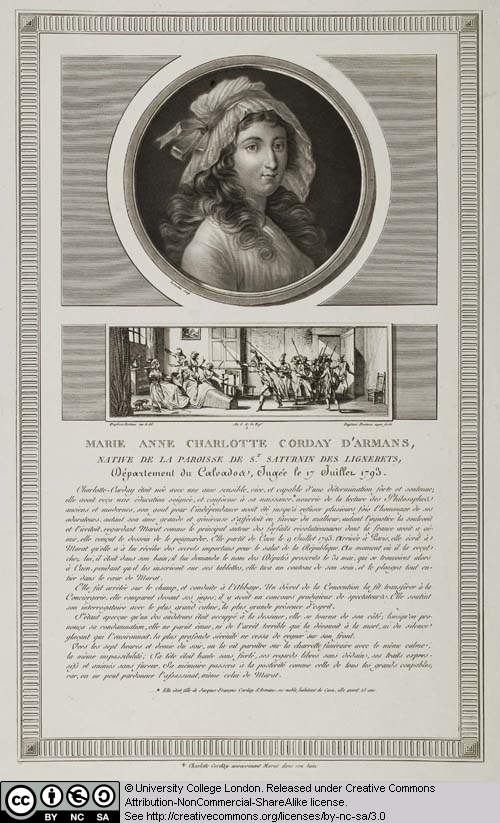21 Le Vachez's Corday

Charles Francois
Gabriel Le Vachez (1760 – 1820) and Jean Duplessi-Bertaux (1747 – 1819)
Marie Anne Charlotte
Corday D’Armans ; Charlotte Corday assassinant Marat dans son bain (Charlotte
Corday assasinates Marat in his bath) , 1802
Etching, engraving and
aquatint
Published in the
series Tableaux historiques de la Révolution française, 1791 – 1817, ( first
included in the edition of 1802 )
The overall tone of this engraving is sympathetic towards
Corday, who in Le Vachez’s portrait is depicted as a beautiful, natural woman,
her long curls falling about her shoulders. In keeping with this,
Duplessi-Bertaux has distanced Corday from the act that made her famous. Rather
than showing her as she stabs Marat, which might have drawn attention to her
capacity for violence and compromised her femininity, she is portrayed in the
moments afterwards, when she is herself about to become the victim. The scene
for her arrest is set and a large crowd of armed men bursts through the door
take her away.
In this vignette we see Duplessi-Bertaux at his most
theatrical, making use of exaggerated gesture to convey the character of the
different personages depicted – Corday, head held high, defiantly rests her
hand against the side of the bath, as if claiming agency for the act. Marat’s
body is grotesquely slumped and his servants hold their hands aloft in horror.
The guards enter with purposeful strides. The use of exaggerated gesture was
perhaps especially necessary given the diminutive size of the characters. Yet
Duplessi-Bertaux seems to play self-consciously with the dramatic potential of
the scene. On the left hand side is a curtain that has been pulled back to let
us see the drama with its heroine centre-stage.
Corday’s strong and virtuous character is described in
glowing terms in the accompanying discourse, and her decision to come to
Licensed under the Creative Commons Attribution Non-commercial Share Alike 3.0 License
This resource has been released as an open educational resource (OER) on a Creative Commons 'Attribution Non-commercial Share Alike' license. This means that once downloaded, content can be modified and improved to complement a particular course. This requires, however, that improvements are recycled back into the OER community. All content present at the time of download must be accordingly credited and, in turn, novel content must be appropriately licensed.